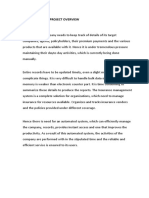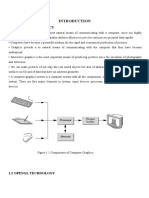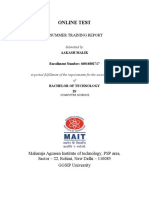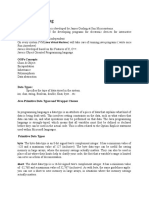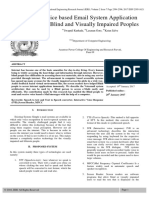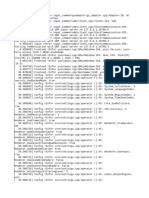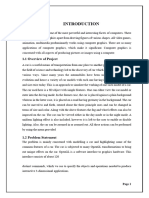Computer Graphics Report
Uploaded by
Shalini G GowdaComputer Graphics Report
Uploaded by
Shalini G GowdaCLOCK OpenGL
Chapter 1
INTRODUCTION
1.1 Introduction to Computer Graphics
Computer Graphics is concerned with all aspects of producing pictures or images
using a computer. We can create images that are indistinguishable from photographs of real
objects. In other terms, Computer Graphics re the graphics created by the computers, and
more generally, the representation and manipulation of image data by a computer.
The development of computer graphics has been driven both by the needs of the user
community and by advances in hardware and software.
Typically, the term Computer Graphics refers to several different things.
The representation and manipulation of image data by a computer.
The various technologies used to create and manipulate images.
The images so produced, and manipulating visual content.
1.2 History of Computer Graphics
The phrase Computer Graphics was coined in 1960 by William Fetter, a graphic
designer for Boeing. The field of Computer Graphics developed with the emergence of
computer graphics hardware. Early projects like the Whirlwind and SAGE projects
introduced the CRT as a viable display and interaction interface and introduced the light pen
as an input device.
Further advances in computing led to greater advancements in interactive computer
graphics. In 1959, the TX-2 computer was developed at MIT's Lincoln Laboratory. A light
pen could be used to draw sketches on the computer using Ivan Sutherland’s
revolutionary Sketchpad software.
Also in 1961 another student at MIT, Steve Russell, created the first video
game, Spacewar. E. E. Zajac, a scientist at Bell Telephone Laboratory (BTL), created a film
called "Simulation of a two-giro gravity attitude control system" in 1963. In this computer
generated film, Zajac showed how the attitude of a satellite could be altered as it orbits the
Dept of CSE,DR.TTIT,KGF 1 2022-23
CLOCK OpenGL
Earth. Many of the most important early breakthroughs in computer graphics research
occurred at the University of Utah in the 1970s.
The first major advance in 3D computer graphics was created at UU by these early
pioneers, the hidden-surface algorithm. In order to draw a representation of a 3D object on
the screen, the computer must determine which surfaces are "behind" the object from the
viewer's perspective, and thus should be "hidden" when the computer creates (or renders) the
image.
Graphics and application processing were increasingly migrated to the intelligence in
the workstation, rather than continuing to rely on central mainframe and mini-computers. 3D
graphics became more popular in the 1990s in gaming, multimedia and animation. Computer
graphics used in films and video games gradually began to be realistic to the point of entering
the uncanny valley. Examples include the later Final Fantasy games and animated films
like The Polar Express.
1.3 Applications of Computer Graphics
The development of computer graphics has been driven both by the needs of the user
community and by advances in hardware and software. The applications of computer
graphics are many and varied. We can however divide them into four major areas.
Display of information: More than 4000 years ago, the Babylonians developed
floor plans of buildings on stones. Today, the same type of information is
generated by architects using computers. Over the past 150 years, workers in
the field of statistics have explored techniques for generating plots. Now, we
have computer plotting packages. Supercomputers now allow researchers in
many areas to solve previously intractable problems. Thus, Computer
Graphics has innumerable applications.
Design: Professions such as engineering and architecture are concerned with
design. Today, the use of interactive graphical tools in CAD, in VLSI circuits,
characters for animation have developed in a great way.
Simulation and animation: One of the most important uses has been in pilots’
training. Graphical flight simulators have proved to increase safety and reduce
expenses. Simulators can be used for designing robots, plan it’s path, etc.
Video games and animated movies can now be made with low expenses.
Dept of CSE,DR.TTIT,KGF 2 2022-23
CLOCK OpenGL
User interfaces: Our interaction with computers has become dominated by a
visual paradigm. The users’ access to internet is through graphical network
browsers. Thus Computer Graphics plays a major role in all fields.
1.4 Introduction to OpenGL
OpenGL is a software interface to graphics hardware. This interface consists of about
150 distinct commands that are used to specify the objects and operations needed to produce
interactive three-dimensional applications. OpenGL is designed as a streamlined hardware-
independent interface to be implemented on many different hardware platforms.
These are certain characteristics of OpenGL:
OpenGL is a better documented API.
OpenGL is much easier to learn and program.
OpenGL has the best demonstrated 3D performance for any API.
The OpenGL specification describes an abstract API for drawing 2D and 3D graphics.
Although it's possible for the API to be implemented entirely in software, it's designed to be
implemented mostly or entirely in hardware.
In addition to being language-independent, OpenGL is also platform-independent.
The specification says nothing on the subject of obtaining, and managing, an OpenGL
context, leaving this as a detail of the underlying windowing system. For the same reason,
OpenGL is purely concerned with rendering, providing no APIs related to input, audio, or
windowing.
OpenGL is an evolving API. New versions of the OpenGL specification are regularly
released by the Khronos Group, each of which extends the API to support various new
features.In addition to the features required by the core API, GPU vendors may provide
additional functionality in the form of extensions. Extensions may introduce new functions
and new constants, and may relax or remove restrictions on existing OpenGL functions.
Vendors can use extensions to expose custom APIs without needing support from other
vendors or the Khronos Group as a whole, which greatly increases the flexibility of OpenGL.
All extensions are collected in, and defined by, the OpenGL Registry.
Dept of CSE,DR.TTIT,KGF 3 2022-23
CLOCK OpenGL
Figure 1.4 OpenGL Pipeline
1.5 Introduction to GLUT
GLUT is the OpenGL utility toolkit, a window system independent toolkit for writing
OpenGL programs. It implements a simple windowing API for OpenGL. GLUT makes it
easier to learn about and explore OpenGL programming. GLUT provides a portable API so
you can write a single OpenGL program that works across all PC and workstation OS
platforms. GLUT is designed for constructing small to medium sized OpenGL programs.
While GLUT is well-suited to learning OpenGL and developing simple OpenGL
applications, GLUT is not a full-featured toolkit so large applications requiring sophisticated
user interfaces are better off using native window system toolkits.The GLUT library has both
C, C++ (same as C), FORTRAN, and ADA programming bindings. The GLUT source code
distribution is portable to nearly all OpenGL implementations and platforms.
Dept of CSE,DR.TTIT,KGF 4 2022-23
CLOCK OpenGL
GLU
Frame
GL buffer
OpenGL
Application
program Xlib, Xtk
GLUT
GLX
Figure 1.5 library organization of OpenGL
1.6 Applications of OpenGL
OpenGL (Open Graphics Library) is a cross-language, multi-platform API for
rendering 2D and 3D computer graphics.
The API is typically used to interact with a GPU, to achieve hardware-
accelerated rendering.
It is widely used in CAD, virtual reality, scientific visualization, information
visualization, flight simulation, and video games.
1.7 OpenGL primitives
OpenGL supports two classes of primitives:
Geometric Primitives
Image(Raster) Primitives
Geometric primitives are specified in the problem domain and include points, line
segments, polygons, curves and surfaces.
Dept of CSE,DR.TTIT,KGF 5 2022-23
CLOCK OpenGL
Raster primitives, such as arrays of pixels pass through a separate parallel pipeline on
their way to the frame buffer.
There are ten basic OpenGL primitives:
Figure 1.7 OpenGL Primitives
Dept of CSE,DR.TTIT,KGF 6 2022-23
CLOCK OpenGL
Chapter 2
HARDWARE AND SOFTWARE REQUIREMENTS
2.1 Hardware Requirements:
Pentium 90MHz Processor or Higher
VGA 640x480 or higher-resolution screen supported by Microsoft Windows.
Recommended 128 MB RAM or Higher (24 MB RAM for Windows 95/98, 32
MB for Windows NT)
100GB SATA (Serial Advanced Technology Attachment) Hard Drive
5400 RPM hard disk drive
DirectX 9 capable video card running at 1024 x 768
DVD-ROM Drive
Input devices: Keyboard, Mouse.
Output devices: Monitor.
2.2 Software Requirements:
Operating System: Microsoft Windows NT 4.0 or later, or Microsoft Windows 95
or later.
Microsoft Visual Studio 6.0
glut.h header file
glut.dll library files
Dept of CSE,DR.TTIT,KGF 7 2022-23
CLOCK OpenGL
Chapter 3
ABOUT THE PROJECT
3.1 Introduction to the project
This mini project on <TITLE> displays a scientific calculator with all the
mathematic functions. Geometrically it is a rectangular calculator with small rectangular
boxes represents the key pad keys and Upper left and right two rectangular boxes indicate the
display screens. It compute normal mathematical calculations and also graphical functions
which generate graphs. Mainly it has calculator key pad which is indicating all the numeric
and function keys, and two display screens.
The calculator keys takes input from keyboard stroke and mouse clicks. The
left side display shows all the inputs and result in normal mathematical form. The right side
display gives the graphical display of mathematical functions.
3.2 User Defined Functions
There are eight user defined functions in the source code of <TITLE>
1. void set_properties()
Used to set properties of the surface material, light source properties and the
camera position.
2. void mouse(int button, int state, int x, int y)
Displays and updates the needles of the clock as per the current time read by the
program.
3. void Draw_gear( void )
Updates the position of the clock gear as per the current matrix stack.
4. void Draw_clock( GLfloat cx, GLfloat cy, GLfloat cz )
Dept of CSE,DR.TTIT,KGF 8 2022-23
CLOCK OpenGL
Used to draw the analog wall clock on the screen.
5. void num()
Displays the numbers on the clock according to orthogonal view.
6. void about()
Displays a small description about the project when the user clicks the
respective mouse button.
7. void display_clock()
Displays the wall clock on the output window.
8. void options(int id)
Used to display a menu along with options regarding the light state, view of the
clock, description and perform the corresponding action.
Dept of CSE,DR.TTIT,KGF 9 2022-23
CLOCK OpenGL
Chapter 4
DESIGN
Initialization
Initialize the interaction with the windows. Initialize the display mode- double buffer
and depth buffer. Initialize the various callback functions for drawing and redrawing, for
mouse and keyboard interfaces. Initialize the input and calculate functions for various
mathematical calculations. Initialize the window position and size and create the window to
display the output.
Flow of control
The flow of control in the below flow chart is respected to the Texture Package. For
any of the program flow chart is compulsory to understand the program. We consider the
flow chart for the texture project in which the flow starts from start and proceeds to the main
function after which it comes to the initialization of call back functions and further it
proceeds to mouse and keyboard functions, input and calculation functions. Finally, it comes
to quit, the end of flow chart.
Dept of CSE,DR.TTIT,KGF 10 2022-23
CLOCK OpenGL
START
MAIN
INITIALIZE CALLBACK FUNCTIONS
MAIN SCREEN DISPLAYED
KEYBOARD MOUSE INTERUPT
READING INPUT STRING
AND ANIMATE MOUSE
END OF INPUT
CALCULATE
PRINT OUTPUT
STOP
Figure 4.1 Project Design
Dept of CSE,DR.TTIT,KGF 11 2022-23
CLOCK OpenGL
Chapter 5
IMPLEMENTATION
5.1 Built-in functions
1. glRasterPos3f( x, y, -1)
Specifies the raster position for pixel operations.
2. glutBitmapCharacter(GLUT_BITMAP_TIMES_ROMAN_24, st[i])
Renders a bitmap charater using OpenGL from the specified array of characters,
and in the specified font style.
3. glutPostRedisplay()
Marks the current window as needing to be redisplayed.
4. glutTimerFunc( 100, TimeEvent, 1)
Registers a timer callback to be triggered in a specified number of milliseconds.
5. glClearColor (0.0, 0.0, 0.0, 0.0)
Specifies clear values for the color buffers.
6. glShadeModel (GL_SMOOTH)
Select flat or smooth shading. Specifies a symbolic value representing a shading
technique. Accepted values are GL_FLAT and GL_SMOOTH.
7. glEnable(GL_DEPTH_TEST)
Enables the OpenGL capabilities, Specifies the conditions under which the pixels
will be drawn.
8. glLightfv(GL_LIGHT1 ,GL_AMBIENT, LightAmbient)
Returns light source parameter values.
9. gluQuadricDrawStyle( Cylinder, GLU_FILL)
Specifies the draw style required for quadrics.
10. glPushMatrix() and glPopMatrix()
Push and pop the current matrix stack.
11. glTranslatef() and glRotatef()
Dept of CSE,DR.TTIT,KGF 12 2022-23
CLOCK OpenGL
Multiplies current matrix by Translation and Rotation matrix respectively.
12. glMatrixMode (GL_PROJECTION)
Specifies which matrix is the current matrix.
13. glLoadIdentity()
Replaces current matrix with identity matrix.
14. gluLookAt()
Defines a viewing transformation.
15. glutSwapBuffers()
Swaps the buffers of the current window if double buffered.
16. glViewport()
Sets the viewport.
17. glutInitDisplayMode (GLUT_DOUBLE | GLUT_RGB)
Sets the initial display mode.
18. glutInitWindowSize (500, 500) and glutInitWindowPosition (50, 50)
Set the initial window size and position respectively.
19. glutCreateWindow()
Creates a top level window with the window name as specified.
20. glutAddMenuEntry()
Adds a menu entry to the bottom of the current menu.
21. glutAttachMenu(GLUT_RIGHT_BUTTON)
Attaches a mouse button for the current window to the identifier of the current
menu.
22. glutDisplayFunc(display)
Sets the display callback for the current window.
23. glutReshapeFunc(reshape)
Sets the reshape callback for the current window.
24. glutMainLoop()
Enters the GLUT event processing loop. This routine should be called at most
once in a GLUT program. Once called, this routine will never return. It will call as
necessary any callbacks that have been registered.
Dept of CSE,DR.TTIT,KGF 13 2022-23
CLOCK OpenGL
5.2 Source Code
#include <GL/glut.h>
#include <string.h>
#include <stdio.h>
#include <stdlib.h>
#include <math.h>
#include <time.h>
int about_int=0;
GLUquadricObj *Cylinder;
GLUquadricObj *Disk;
struct tm *newtime;
time_t ltime;
int M_TWOPI=0;
GLfloat rx, ry, rz, angle;
// lighting
GLfloat LightAmbient[]= { 0.5f, 0.5f, 0.5f, 1.0f };
GLfloat LightDiffuse[]= { 0.5f, 0.5f, 0.5f, 1.0f };
GLfloat LightPosition[]= { 5.0f, 25.0f, 15.0f, 1.0f };
GLfloat mat_specular[] = { 1.0, 1.0, 1.0, 1.0 };
static int light_state = 1; // light on = 1, light off = 0
static int view_state = 1; // Ortho view = 1, Perspective = 0
void Sprint( float x, float y, char *st)
Dept of CSE,DR.TTIT,KGF 14 2022-23
CLOCK OpenGL
int l,i;
l=strlen( st );
glRasterPos3f( x, y, -1);
for( i=0; i < l; i++)
glutBitmapCharacter(GLUT_BITMAP_TIMES_ROMAN_24, st[i]);
static void TimeEvent(int te)
rx = 30 * cos( angle );
ry = 30 * sin( angle );
rz = 30 * cos( angle );
angle += 0.01;
if (angle > M_TWOPI) angle = 0;
glutPostRedisplay();
glutTimerFunc( 100, TimeEvent, 1);
void init(void)
glClearColor (0.0, 0.0, 0.0, 0.0);
glShadeModel (GL_SMOOTH);
glEnable(GL_DEPTH_TEST);
// Lighting is added to scene
glLightfv(GL_LIGHT1 ,GL_AMBIENT, LightAmbient);
glLightfv(GL_LIGHT1 ,GL_DIFFUSE, LightDiffuse);
glLightfv(GL_LIGHT1 ,GL_POSITION, LightPosition);
glEnable(GL_LIGHTING);
Dept of CSE,DR.TTIT,KGF 15 2022-23
CLOCK OpenGL
glEnable(GL_LIGHT1);
Cylinder = gluNewQuadric();
gluQuadricDrawStyle( Cylinder, GLU_FILL);
gluQuadricNormals( Cylinder, GLU_SMOOTH);
gluQuadricOrientation( Cylinder, GLU_OUTSIDE);
gluQuadricTexture( Cylinder, GL_TRUE);
Disk = gluNewQuadric();
gluQuadricDrawStyle( Disk, GLU_FILL);
gluQuadricNormals( Disk, GLU_SMOOTH);
gluQuadricOrientation( Disk, GLU_OUTSIDE);
gluQuadricTexture( Disk, GL_TRUE);
void Draw_gear( void )
int i;
glPushMatrix();
gluCylinder(Cylinder, 2.5, 2.5, 1, 16, 16);
gluDisk(Disk, 0, 2.5, 32, 16);
glTranslatef(0,0,1);
gluDisk(Disk, 0, 2.5, 32, 16);
glPopMatrix();
for( i = 0; i < 8; i++)
glPushMatrix();
glTranslatef( 0.0, 0.0, 0.50);
glRotatef( (360/8) * i, 0.0, 0.0, 1.0);
glTranslatef( 3.0, 0.0, 0.0);
glutSolidCube( 1.0 );
Dept of CSE,DR.TTIT,KGF 16 2022-23
CLOCK OpenGL
glPopMatrix();
void Draw_clock( GLfloat cx, GLfloat cy, GLfloat cz )
int hour_ticks , sec_ticks;
glPushMatrix();
glTranslatef(cx,cy,cz);
glRotatef( 180, 1.0, 0.0, 0.0);
/*glPushMatrix(); // Draw large wire cube (outside of disk clock)
glColor3f(1.0, 1.0, 1.0);
glTranslatef( 0.0, 0.0, 6.0);
glutWireCube(14.0);
glPopMatrix();*/
glPushMatrix(); // Draw clock face
glTranslatef( 0, 0, 1.0);
gluDisk(Disk, 0, 6.75, 32, 16);
glPopMatrix();
glPushMatrix();// Draw hour hand
glColor3f(1.0, 0.5, 0.5);
glTranslatef( 0, 0, 0.0);
glRotatef( (360/12) * newtime->tm_hour + (360/60) * (60 / (newtime->tm_min+1)), 0.0, 0.0, 1.0);
glPushMatrix();
glTranslatef(0.0, 0.0, 2.0);
Draw_gear();
glPopMatrix();
glRotatef( 90, 1.0, 0.0, 0.0);
gluCylinder(Cylinder, 0.75, 0, 4, 16, 16);
Dept of CSE,DR.TTIT,KGF 17 2022-23
CLOCK OpenGL
glPopMatrix();
glPushMatrix();// Draw minute hand
glColor3f(1.0, 0.5, 1.0);
glTranslatef( 0, 0, 0.0);
glRotatef( (360/60) * newtime->tm_min, 0.0, 0.0, 1.0);
glPushMatrix();
glTranslatef(0.0, 0.0, 3.0);
glScalef(0.5, 0.5, 1.0);
Draw_gear();
glPopMatrix();
glRotatef( 90, 1.0, 0.0, 0.0);
gluCylinder(Cylinder, 0.5, 0, 6, 16, 16);
glPopMatrix();
glPushMatrix();// Draw second hand
glColor3f(1.0, 0.0, 0.5);
glTranslatef( 0, 0, -0.0);
glRotatef( (360/60) * newtime->tm_sec, 0.0, 0.0, 1.0);
glPushMatrix();
glTranslatef(0.0, 0.0, 4.0);
glScalef(0.25, 0.25, 1.0);
Draw_gear();
glPopMatrix();
glRotatef( 90, 1.0, 0.0, 0.0);
gluCylinder(Cylinder, 0.25, 0, 6, 16, 16);
glPopMatrix();
for(hour_ticks = 0; hour_ticks < 12; hour_ticks++)
glPushMatrix();// Draw next arm axis.
Dept of CSE,DR.TTIT,KGF 18 2022-23
CLOCK OpenGL
glColor3f(0.0, 1.0, 1.0); // give it a color
glTranslatef(0.0, 0.0, 0.0);
glRotatef( (360/12) * hour_ticks, 0.0, 0.0, 1.0);
glTranslatef( 6.0, 0.0, 0.0);
glutSolidCube(1.0);
glPopMatrix();
for(sec_ticks = 0; sec_ticks < 60; sec_ticks++)
glPushMatrix();
glTranslatef(0.0, 0.0, 0.0);
glRotatef( (360/60) * sec_ticks, 0.0, 0.0, 1.0);
glTranslatef(6.0, 0.0, 0.0);
glutSolidCube(0.25);
glPopMatrix();
glPopMatrix();
void num()
if(view_state == 1)
glColor3f( 0.0, 0.0, 1.0);
Sprint(-6.2,-0.2,"9"); //counting from center
Sprint(-0.2,-6.2,"6");
Sprint(-0.4,5.7,"12");
Sprint(5.8,-0.2,"3");
Dept of CSE,DR.TTIT,KGF 19 2022-23
CLOCK OpenGL
void about()
//glClear(GL_COLOR_BUFFER_BIT);
glColor3f( 1.0, 1.0, 1.0);
Sprint(-5,-2,"This project implements the clock");
Sprint(-5,-2.8," Both Wall clock and digit clock");
Sprint(-5,-3.6," is displayed");
Sprint(-5,-4.4," Clock shows the local time");
Sprint(-5,-5.2," fetching from computer");
//glFlush();
void display_clock()
time(<ime); // Get time
newtime = localtime(<ime); // Convert to local time
glClear (GL_COLOR_BUFFER_BIT | GL_DEPTH_BUFFER_BIT);
// easy way to put text on the screen.
glMatrixMode (GL_PROJECTION);
glLoadIdentity();
glOrtho(-8.0, 8.0, -8.0, 8.0, 1.0, 60.0);
glMatrixMode(GL_MODELVIEW);
glLoadIdentity();
glDisable(GL_LIGHTING);
glDisable(GL_COLOR_MATERIAL);
// Put view state on screen
glColor3f( 1.0, 1.0, 1.0);
if (view_state == 0 && about_int==0)
Dept of CSE,DR.TTIT,KGF 20 2022-23
CLOCK OpenGL
Sprint(-3, -4, "Perspective view");
else if (view_state != 0 && about_int==0)
Sprint(-2, -4, "Ortho view");
else
about();
Sprint(-4,-7.7, asctime(newtime));
// Turn Perspective mode on/off
if (view_state == 0)
glMatrixMode (GL_PROJECTION);
glLoadIdentity();
gluPerspective(60.0, 1, 1.0, 60.0);
glMatrixMode(GL_MODELVIEW);
glLoadIdentity();
gluLookAt( rx, 0.0, rz, 0.0, 0.0, -14.0, 0, 1, 0);
if (light_state == 1)
glEnable(GL_LIGHTING);
glEnable(GL_COLOR_MATERIAL); // Enable for lighing
}else
Dept of CSE,DR.TTIT,KGF 21 2022-23
CLOCK OpenGL
glDisable(GL_LIGHTING);
glDisable(GL_COLOR_MATERIAL); // Disable for no lighing
Draw_clock( 0.0, 0.0, -14.0);
num();
glutSwapBuffers();
void display(void)
glClear(GL_COLOR_BUFFER_BIT);
display_clock();
glFlush();
void reshape (int w, int h)
glViewport (0, 0, (GLsizei) w, (GLsizei) h);
glMatrixMode (GL_PROJECTION);
glLoadIdentity ();
void options(int id)
switch(id)
case 1:
glClear(GL_COLOR_BUFFER_BIT|GL_DEPTH_BUFFER_BIT);
about_int= abs(about_int - 1);
break;
case 2:
Dept of CSE,DR.TTIT,KGF 22 2022-23
CLOCK OpenGL
glClear(GL_COLOR_BUFFER_BIT|GL_DEPTH_BUFFER_BIT);
view_state = abs(view_state - 1);
break;
case 3:
glClear(GL_COLOR_BUFFER_BIT|GL_DEPTH_BUFFER_BIT);
light_state = abs(light_state - 1);
break;
case 4 :
exit(0);
int main(int argc, char** argv)
glutInit(&argc, argv);
glutInitDisplayMode (GLUT_DOUBLE | GLUT_RGB);
glutInitWindowSize (500, 500);
glutInitWindowPosition (50, 50);
glutCreateWindow (argv[0]);
glutSetWindowTitle("GLclock");
init ();
glutCreateMenu(options);
glutAddMenuEntry("About the Project",1);
glutAddMenuEntry("Toggle Ortho/Perspective view",2);
glutAddMenuEntry("Light on/off",3);
glutAddMenuEntry("Quit",4);
glutAttachMenu(GLUT_RIGHT_BUTTON);
glutDisplayFunc(display);
glutReshapeFunc(reshape);
Dept of CSE,DR.TTIT,KGF 23 2022-23
CLOCK OpenGL
glutTimerFunc( 10, TimeEvent, 1);
glutMainLoop();
return 0;
Chapter 6
TESTING
Testing in general means validation and verification. It shows that the system
conforms to its specifications and system meets all expectation of the user.
6.1 Test case for mouse:
Sl. No. Test Case Expected Result Actual Result Remarks
Description
1. Click the RIGHT Menu with Menu with Pass
mouse button on Toggle Toggle
the display screen. Ortho/Perspective Ortho/Perspective
View View
Light ON/OFF Light ON/OFF
About the project About the project
Quit Quit
Should be displayed. Is displayed.
6.2 Test case for menu options:
Sl. No. Test Case Expected Result Actual Result Remarks
Description
1. Click on Toggle The user should be able The user is able to toggle Pass
Ortho/Perspective to toggle between these between these two views.
view option two views.
2. Click on Light The user should be able The user is able to turn Pass
ON/OFF option to turn ON or OFF the ON or OFF the
brightness feature. brightness feature.
3. Click on About A short description of the A short description of the Pass
the project option project should be project is displayed on
displayed on the window. the window.
4. Click on Quit The window should be The window is Pass
option terminated. terminated.
Dept of CSE,DR.TTIT,KGF 24 2022-23
CLOCK OpenGL
Chapter 7
SNAPSHOTS
Figure 7.1 Initial View
Dept of CSE,DR.TTIT,KGF 25 2022-23
CLOCK OpenGL
Figure 7.2 Menu with options:
Figure7.3 Ortho view:
Dept of CSE,DR.TTIT,KGF 26 2022-23
CLOCK OpenGL
Figure 7.4 Perspective view
Figure 7.5 Brightness ON
Dept of CSE,DR.TTIT,KGF 27 2022-23
CLOCK OpenGL
Figure7.6 Brightness OFF
Dept of CSE,DR.TTIT,KGF 28 2022-23
CLOCK OpenGL
Figure7.7 Window with description of the project
Chapter 8
CONCLUSION
This mini project on CLOCK using OpenGL is a reliable graphics package that
provides the user with the basic working of an analog as well as a digital clock. It provides
the user with certain other operations like toggling between two different kinds of views,
adjusting the brightness by turning the lights on or off, also allows the user to read a short
description of what the project is about. The user-friendly interface allows the user to interact
with it very effectively.
Dept of CSE,DR.TTIT,KGF 29 2022-23
CLOCK OpenGL
Chapter 9
FUTURE ENHANCEMENTS
This project has been designed such that it works on the windows platform. The
project can be designed using different languages and better graphical interfaces. The
following features can be incorporated.
A simple monthly calendar can be displayed along with the clock.
A simple digital timer can be implemented.
Better graphical features like options for the user to change the clock’s color
and shape of the clock.
A different style for the digits on the clock, for example, Roman Numbers.
Dept of CSE,DR.TTIT,KGF 30 2022-23
CLOCK OpenGL
BIBLIOGRAPHY
BOOKS:
Edward Angel, “Interactive Computer Graphics”,5th edition, Pearson Education,2005
Jackie L. Neider, Mark Warhol, Tom R. Davies, ”OpenGL Red Book”, 2 nd Revised
Edition,2005
Donald D Hearn and M. Pauline Baker, “Computer Graphics with OpenGL”, 3rd
edition.
F.S.Hill and Stephen M.Kelly,”Computer Graphics using OpenGL”, 3rd edition.
WEBSITES:
http://www.opengl.org
http://www.wikipedia.com
http://basic4gl.wikispaces.com
http://openglprojects.in
Dept of CSE,DR.TTIT,KGF 31 2022-23
You might also like
- A Project On Online Ticket Booking SystemNo ratings yetA Project On Online Ticket Booking System14 pages
- Online Electicity Biiiling Report FinalNo ratings yetOnline Electicity Biiiling Report Final22 pages
- Accident Detection System Project Report.No ratings yetAccident Detection System Project Report.39 pages
- Curfew E-Pass Management System: A SurveyNo ratings yetCurfew E-Pass Management System: A Survey3 pages
- Online Bus Reservation System Project ReportNo ratings yetOnline Bus Reservation System Project Report62 pages
- Student Information System: 1. List of FiguresNo ratings yetStudent Information System: 1. List of Figures37 pages
- Project-II (Music Streamming Web Applications)No ratings yetProject-II (Music Streamming Web Applications)41 pages
- Green Screen Background Remover Using CV SystemNo ratings yetGreen Screen Background Remover Using CV System20 pages
- Voice Based Email System Application For Blind and Visually Impaired PeoplesNo ratings yetVoice Based Email System Application For Blind and Visually Impaired Peoples3 pages
- Design and Implementation of Security Management Using Data Encryption and Decryption Techniquesfjo1nr4mf100% (1)Design and Implementation of Security Management Using Data Encryption and Decryption Techniquesfjo1nr4mf12 pages
- Project On Hotel Reservation and Room Allocation in C#No ratings yetProject On Hotel Reservation and Room Allocation in C#35 pages
- Employee Management System: Project Report ONNo ratings yetEmployee Management System: Project Report ON79 pages
- Tictactoe Game Management System Project ReportNo ratings yetTictactoe Game Management System Project Report30 pages
- 1.1 Computer Graphics:: Flowing FountainNo ratings yet1.1 Computer Graphics:: Flowing Fountain32 pages
- Evolution of Graphics API: Sujal Bista CMSC 828VNo ratings yetEvolution of Graphics API: Sujal Bista CMSC 828V26 pages
- Ludo Presentation 150306215233 Conversion Gate01 PDFNo ratings yetLudo Presentation 150306215233 Conversion Gate01 PDF16 pages
- Developer - Android.com-Run Apps On The Android EmulatorNo ratings yetDeveloper - Android.com-Run Apps On The Android Emulator19 pages
- Workshop Grafika Komputer - Primitive DrawingNo ratings yetWorkshop Grafika Komputer - Primitive Drawing24 pages
- Voice Based Email System Application For Blind and Visually Impaired PeoplesVoice Based Email System Application For Blind and Visually Impaired Peoples
- Design and Implementation of Security Management Using Data Encryption and Decryption Techniquesfjo1nr4mfDesign and Implementation of Security Management Using Data Encryption and Decryption Techniquesfjo1nr4mf
- Project On Hotel Reservation and Room Allocation in C#Project On Hotel Reservation and Room Allocation in C#
- Bug tracking system Complete Self-Assessment GuideFrom EverandBug tracking system Complete Self-Assessment Guide
- Ludo Presentation 150306215233 Conversion Gate01 PDFLudo Presentation 150306215233 Conversion Gate01 PDF
- Developer - Android.com-Run Apps On The Android EmulatorDeveloper - Android.com-Run Apps On The Android Emulator





